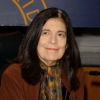Susan Sontag

Susan Sontag
Susan Sontagwas an American writer, filmmaker, teacher and political activist. She published her first major work, the essay "Notes on 'Camp'", in 1964. Her best-known works include On Photography, Against Interpretation, Styles of Radical Will, The Way We Live Now, Illness as Metaphor, Regarding the Pain of Others, The Volcano Lover and In America...
NationalityAmerican
ProfessionAuthor
Date of Birth16 January 1933
CountryUnited States of America
ignorance charming
My ignorance is not charming.
photography art mean
To us, the difference between the # photographer as an individual eye and the photographer as an objective recorder seems fundamental, the difference often regarded, mistakenly, as separating photography as art from # photography as document. But both are logical extensions of what photography means: note-taking on, potentially, everything in the world, from every possible angle.
wall book emotional
Because each photograph is only a fragment, its moral and emotional weight depends on where it is inserted. A photograph changes according to the context in which it is seen: thus Smith's Minamata photographs will seem different on a contact sheet, in a gallery, in a political demonstration, in a police file, in a photographic magazine, in a book, on a living-room wall. Each o these situations suggest a different use for the photographs but none can secure their meaning.
art real hands
Knowing a great deal about what is in the world art, catastrophe, the beauties of nature through photographic images, people are frequently disappointed, surprised, unmoved when the see the real thing. For photographic images tend to subtract feeling from something we experience at first hand and the feelings they do arouse are, largely, not those we have in real life. Often something disturbs us more in photographed form than it does when we actually experience it.
art revenge order
Interpretation is the revenge of the intellect upon art. Even more. It is the revenge of the intellect upon the world. To interpret is to impoverish, to deplete the world -- in order to set up a shadow world of ''meanings.''
photography vocabulary language
In contrast to the written account-which, depending on its complexity of thought, reference, and vocabulary, is pitched at a larger or smaller readership-a photograph has only one language and is destined potentially for all.
photography art lying
Although photography generates works that can be called art-it requires subjectivity, it can lie, it gives aesthetic pleasure-photography is not, to begin with, an art form at all. Like language, it is a medium in which works of art (among other things) are made.
suffering doe compassionate
To suffer is one thing; another thing is living with the photographed images of suffering, which does not necessarily strengthen conscience and the ability to be compassionate. It can also corrupt them. Once one has seen such images, one has started down the road of seeing more - and more. Images transfix. Images anesthetize.
photography events turns
Photographs objectify: they turn an event or a person into something that can be possessed.
writing great-writers stills
A great writer has all 4 - but you can still be a good writer with only 1 and 2.
art world commentary
Art is not only about something; it is something. A work of art is a thing in the world, not just a text or commentary on the world.
death sex pornography
What pornography is really about, ultimately, isn't sex but death.
disease sexuality register
Fear of sexuality is the new, disease-sponsored register of the universe of fear in which everyone now lives.
art intellectual decay
Unfortunately, moral beauty in art - like physical beauty in a person - is extremely perishable. It is nowhere so durable as artistic or intellectual beauty. Moral beauty has a tendency to decay very rapidly into sententiousness or untimeliness.